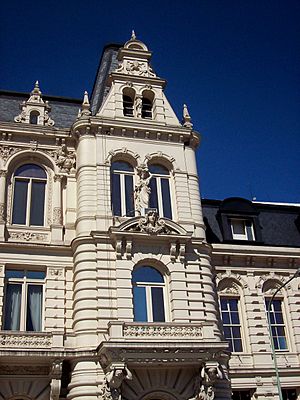Pizzurno Palace facts for kids
The Sarmiento Palace, also known as the Pizzurno Palace, is a famous building in Buenos Aires, Argentina. It's located in the beautiful Recoleta area. Today, this grand palace is where the Argentine Ministry of Education has its main offices.
Contents
A Palace for Education
The story of the Sarmiento Palace began with a kind lady named Petronila Rodríguez de Rojas. When she passed away in 1882, she left her large piece of land, about 6 hectares (15 acres), to the city. She wanted the land to be used for education and charity. Her wish was for a school for at least 700 girls, along with a church and a home for the elderly.
The city hired two architects, Carlos Adolfo Altgelt and Hans Altgelt, to design the school. Construction started in 1886. Mrs. Rojas also wanted the building to have a big museum and a library.
Building Design and Opening
The palace was designed in a special style called "eclectic." This means it mixed different ideas from other styles. It was inspired by Second Empire architecture and looked like buildings from the French and German Renaissance Revival architecture. The building was finished in 1888. The Petronila Rodríguez de Rojas School officially opened its doors in 1893.
From School to Ministry
This impressive building was soon chosen for government use. In 1903, the National Education Council moved in. This council used to manage Argentina's national secondary schools. The building was later renamed the Sarmiento Palace. This was to honor Domingo Sarmiento, a former Education Minister and President of Argentina. He believed strongly in "the education of a sovereign people" during his time as president from 1868 to 1874.
In 1980, the Ministry of Education moved into the palace. Even though its official name is Sarmiento Palace, many people call it the Pizzurno Palace. This is because of the street next to it, which was named after Pablo Pizzurno. He was an important teacher and a pioneer of the primary school system in Argentina.
Location and Surroundings
The palace is located across from the green Rodríguez Peña Plaza. This makes it a quiet spot in the busy Barrio Norte area of Recoleta. In the 1950s, a playground called Petronila Rodríguez de Rojas Plaza was created next to the palace. This was a way to remember the generous lady who started it all.
See also
 In Spanish: Palacio Sarmiento para niños
In Spanish: Palacio Sarmiento para niños
Images for kids




